*NURSING > QUESTIONS & ANSWERS > NR511 DAVIS EDGE WEEK 5-8; MUSCULOSKELETAL PROBLEMS ( 60 Questions, Answers and Rationales) (All)
NR511 DAVIS EDGE WEEK 5-8; MUSCULOSKELETAL PROBLEMS ( 60 Questions, Answers and Rationales)
Document Content and Description Below
NR511 DAVIS EDGE WEEK 5-8; MUSCULOSKELETAL PROBLEMS Question 1. A 13-year-old obese (body mass index [BMI] above the 95th percentile) boy reports low-grade left knee pain for the past 2 months. He ... denies antecedent trauma but admits to frequent “horseplay” with his friends. The pain has progressively worsened, and he is now unable to bear weight at all on his left leg. His current complaints include left groin, thigh, and medial knee pain and tenderness. His examination demonstrates negative drawer, Lachman, and McMurray tests; left hip with decreased internal rotation and abduction; and external hip rotation with knee flexion. Based on the above scenario, the nurse practitioner should suspect: 1. A left meniscal tear. 2. A left anterior cruciate ligament (ACL) tear. 3. A slipped capital femoral epiphysis (SCFE). 4. Osgood-Schlatter disease. Rationales Option 1: There would be a positive McMurray sign in a meniscal tear. Option 2: There would be a positive Lachman and/or drawer test in an ACL tear. Option 3: SCFE is a displacement of the femoral head relative to the femoral neck that occurs through the physis (growth plate) of the femur. The vast majority of clients with this condition are obese, as the added weight increases shear stress across the physis. The mean age at diagnosis is 12 years for females and 13.5 years for males. Surgery is often required via in situ pin fixation (single screw) to stabilize the growth plate to prevent further slippage and avoid complications. Option 4: Osgood-Schlatter disease would result in swelling, pain, and tenderness at the tibial tubercle. Question 2. In assessing the skeletal muscles, the nurse practitioner turns the patient’s forearm so that the palm is up. This is called: 1. Supination. 2. Pronation. 3. Abduction. 4. Eversion. Rationales Option 1: Turning the forearm so that the palm is up is called supination. Option 2: Turning the forearm so that the palm is down is called pronation. Option 3: Moving a limb away from the midline of the body is called abduction. Option 4: Moving the sole of the foot outward at the ankle is called eversion. Question 3. Cass, age 67, tells the nurse practitioner (NP) that she has been diagnosed with a condition that causes sudden flares of pain, swelling, and redness of the joints in her toes. She cannot remember the name of the diagnosis, but she knows it is caused by urate crystals that “get stuck in the joint and cause pain.” She is on hydrochlorothiazide (HCTZ) for management of her hypertension. The NP should suspect a diagnosis of: 1. Septic arthritis. 2. Gout. 3. Rheumatoid arthritis. 4. Charcot neuro-osteoarthropathy. Rationales Option 1: Like gout, septic arthritis presents with an acute onset of swelling, pain, and heat in a joint. However, unlike gout, it occurs most frequently in the knee, followed by the hip, shoulder, wrist, and ankle. Option 2: Gout is a disorder that involves abnormal metabolism of uric acid and results in hyperuricemia. High concentrations of urate precipitate into crystals that collect in tissue and joint spaces and can cause pain and inflammation. The patient’s symptoms may be aggravated by the use of HCTZ. Option 3: Rheumatoid arthritis typically affects multiple joints simultaneously and is a slow and progressive disease. Option 4: Charcot neuro-osteoarthropathy occurs in diabetic patients and presents as hot, swollen, and red joints. These patients usually report a history of trauma, surgery, or prior infection.2 DAVIS EDGE WEEK 5-8 Question 4. Matthew, age 52, is a chef who just severed 2 of his fingers with a meat cutter. You would recommend that he: 1. Wrap the severed fingers tightly in a dry towel for transport to the emergency department with him. 2. Leave the severed fingers at the scene because fingers cannot be reattached. 3. Immediately freeze the severed fingers for reattachment in the near future. 4. Wrap the fingers in a clean, damp cloth; seal them in a plastic bag; and place the bag in an ice water bath. Rationales Option 1: Severed fingers should be wrapped in a clean, damp cloth; sealed in a plastic bag; and placed in an ice water bath. Option 2: Severed fingers can be reattached after 1 to 2 days—or more—if properly stored. Option 3: Severed fingers should be wrapped in a clean, damp cloth; sealed in a plastic bag; and placed in an ice water bath, not frozen or kept at body temperature. Option 4: If a client has severed his fingers, the fingers should be wrapped in a clean, damp cloth; sealed in a plastic bag; placed in an ice water bath; and transported to the emergency room along with the client. Question 5. Marsha, age 34, presents with symptoms resembling both fibromyalgia and chronic fatigue syndrome, which have many similarities. Which of the following is more characteristic of fibromyalgia than of chronic fatigue syndrome? 1. Musculoskeletal pain. 2. Difficulty sleeping. 3. Depression. 4. Fatigue. Rationales Option 1: Musculoskeletal pain is not characteristic of chronic fatigue syndrome; rather, it is characteristic of fibromyalgia. The musculoskeletal pain, usually an achy muscle pain that may be localized or involve the entire body, is usually gradual in onset, although the onset may occasionally be sudden, such as after a viral illness. Option 2: Difficulty sleeping occurs with both disorders. Option 3: Depression occurs with both disorders. Option 4: Fatigue is a more significant feature of chronic fatigue syndrome. Question 6. Mrs. Kelly, age 80, has a curvature of the spine. This is likely to indicate which age-related change? 1. Lordosis. 2. Dorsal kyphosis. 3. Scoliosis. 4. Kyphoscoliosis. Rationales Option 1: Lordosis occurs when the normal lumbar concavity is further accentuated, such as with pregnancy or obesity. Option 2: Dorsal kyphosis, an exaggerated convexity of the thoracic curvature, typically accompanies the aging process. Option 3: Scoliosis, which is more prevalent in adolescent girls, is a lateral S- or C-shaped curvature of the thoracic and/or lumbar spine that can also involve vertebral rotation. Option 4: Kyphoscoliosis is a combination of kyphosis and scoliosis that involves curvature in both the coronal and sagittal planes. Question 7. The valgus stress test, varus stress test, Lachman test, and thumb sign are all considered standard tests to check the integrity of the ligaments of the knee. Which test would the nurse practitioner choose to assess the anterior cruciate ligament (ACL), which is the most commonly involved structure in severe knee injury? 1. Valgus stress test. 2. Varus stress test.3 DAVIS EDGE WEEK 5-8 3. Lachman test. 4. Thumb sign. Rationales Option 1: The valgus stress test assesses stability of the medial collateral ligament (MCL). Option 2: The varus stress test assesses stability of the lateral collateral ligament (LCL). Option 3: The Lachman test assesses the ACL. Option 4: The thumb sign assesses the posterior cruciate ligament (PCL). Question 8. Lillian, age 70, was told that she has osteoporosis. When she asks you what this is, you respond that osteoporosis: 1. Develops when loss of bone occurs more rapidly than new bone growth. 2. Is a degenerative joint disease characterized by loss of cartilage in certain joints. 3. Is a chronic inflammatory disorder that affects multiple joints. 4. Is a bone disorder that has to do with inadequate mineralization of the bones. Rationales Option 1:Osteoporosis develops when bone resorption occurs more rapidly than bone deposition. Option 2: Osteoarthritis is a degenerative joint disease characterized by degeneration and loss of articular cartilage in synovial joints. Option 3: Rheumatoid arthritis is a chronic, systemic inflammatory disorder characterized by persistent synovitis of multiple joints. Option 4: Osteomalacia is a metabolic bone disorder characterized by inadequate mineralization of the bone matrix, often caused by vitamin D deficiency. Question 9. Mike, age 42, a golf pro, has had chronic back pain for many years. His workup reveals that it is not the result of a degenerative disk problem. His back “goes out” about twice per year, and he is out of work for about a week each time. Which of the following should the nurse practitioner advise him to do? 1. Consider changing careers to something less physical. 2. Begin a planned exercise program to strengthen back muscles. 3. Make an appointment with a neurosurgeon for a surgical consultation. 4. Start on a daily low-dose narcotic to take away the pain. Rationales Option 1: Suggesting a career change should be considered only in cases of disability or inability to safely continue one’s current employment. Option 2: In this case, Mike may benefit from a regular planned exercise program to strengthen his back muscles and attempt to reduce the probability of future episodes of back pain. Option 3: Surgery is recommended only for clients with low back pain caused by degenerative disk disorders, and then only when severe neurologic involvement has occurred. Surgery benefits only approximately 1% of people with low back problems. Option 4: Narcotic pain medications are not considered first-line treatment for mechanical back pain. Question 10. Janine, age 69, has class III rheumatoid arthritis. According to the American Rheumatism Association, which of the following describes her ability to function? 1. Adequate for normal activities despite a handicap of discomfort or limited motion of one or more joints. 2. Largely or wholly incapacitated, bedridden, or confined to a wheelchair, permitting little or no self-care. 3. Completely able to carry out all usual duties without handicap. 4. Adequate to perform only a few or none of the duties of usual occupation or self-care. Rationales Option 1: Class II refers to the client whose function is adequate for normal activities despite a handicap of discomfort or limited motion of one or more joints. Option 2: Class IV refers to the client who is largely or wholly incapacitated, bedridden, or confined to a wheelchair, permitting little or no self-care. Option 3: Class I refers to the client who can carry out all usual duties without handicap.4 DAVIS EDGE WEEK 5-8 Option 4: The American Rheumatism Association has established functional classes I to IV to describe a client’s ability to accomplish activities of daily living. Because Janine is class III, her function would be adequate to perform only a few or none of the duties of usual occupation or self-care. Question 11. Mickey, age 18, is on a chemotherapeutic antibiotic for a musculoskeletal neoplasm. Which drug do you think he is taking? 1. Cyclophosphamide (Cytoxan). 2. Doxorubicin (Adriamycin). 3. Methotrexate (Rheumatrex). 4. Cisplatin (Platinol). Rationales [Show More]
Last updated: 1 year ago
Preview 1 out of 18 pages
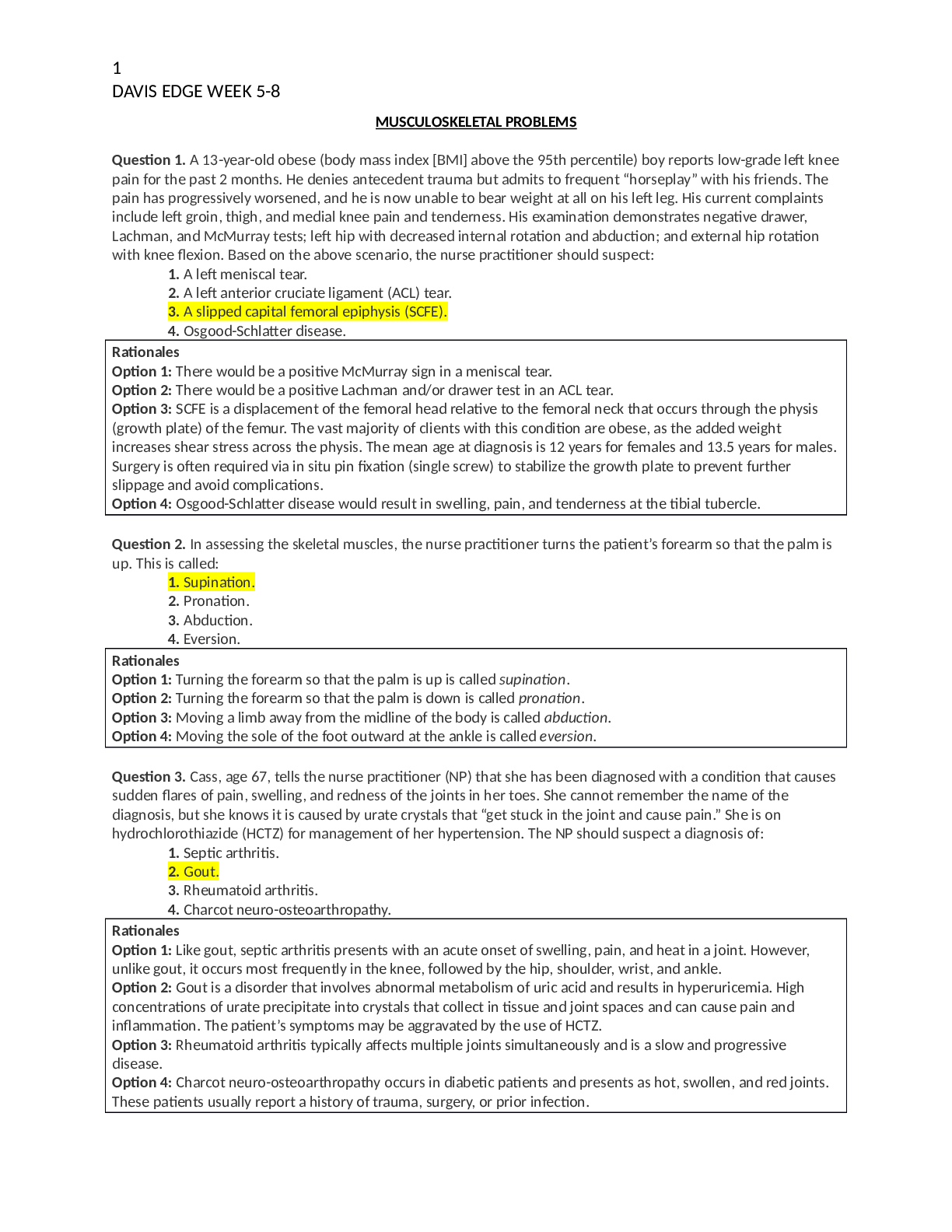
Reviews( 0 )
Document information
Connected school, study & course
About the document
Uploaded On
Apr 17, 2022
Number of pages
18
Written in
Additional information
This document has been written for:
Uploaded
Apr 17, 2022
Downloads
0
Views
54

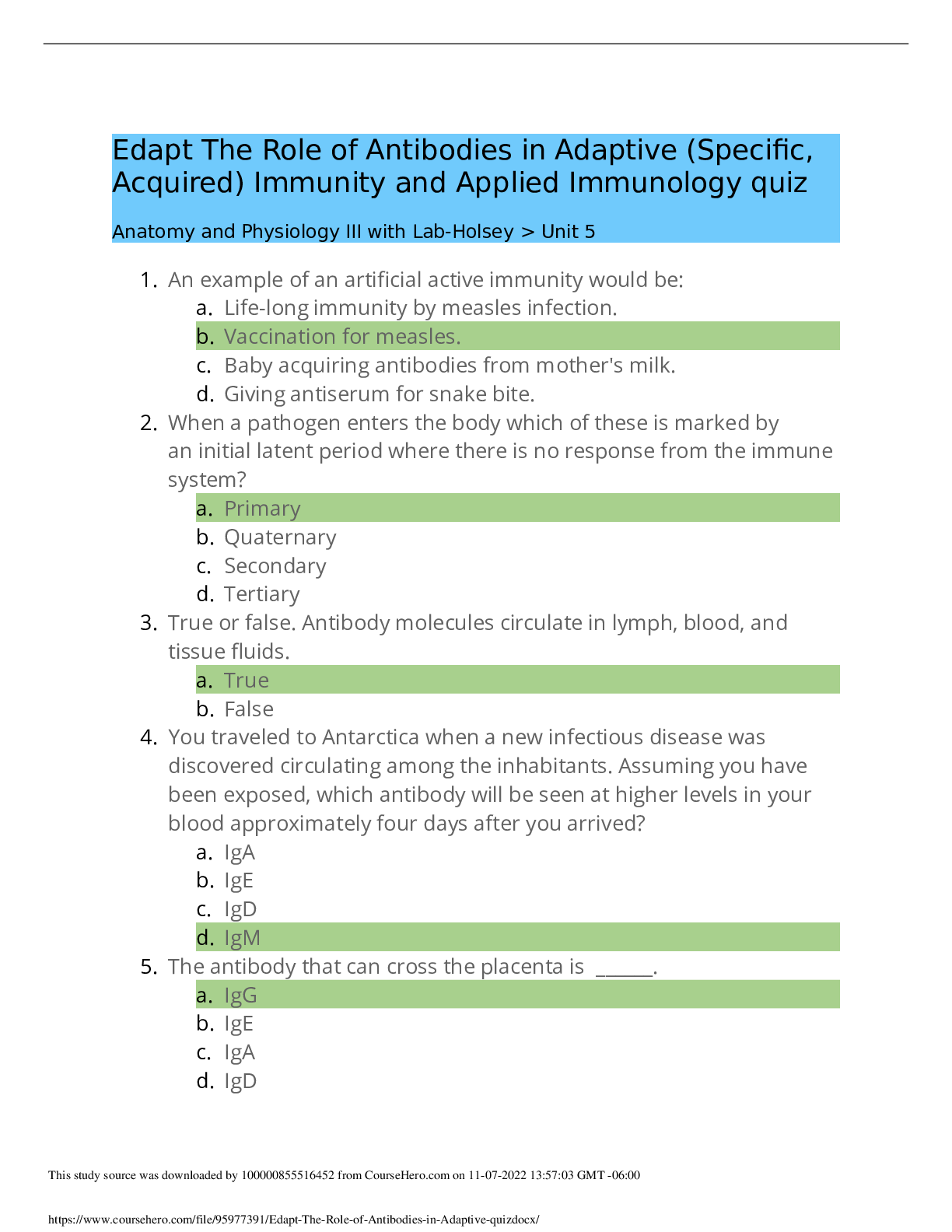
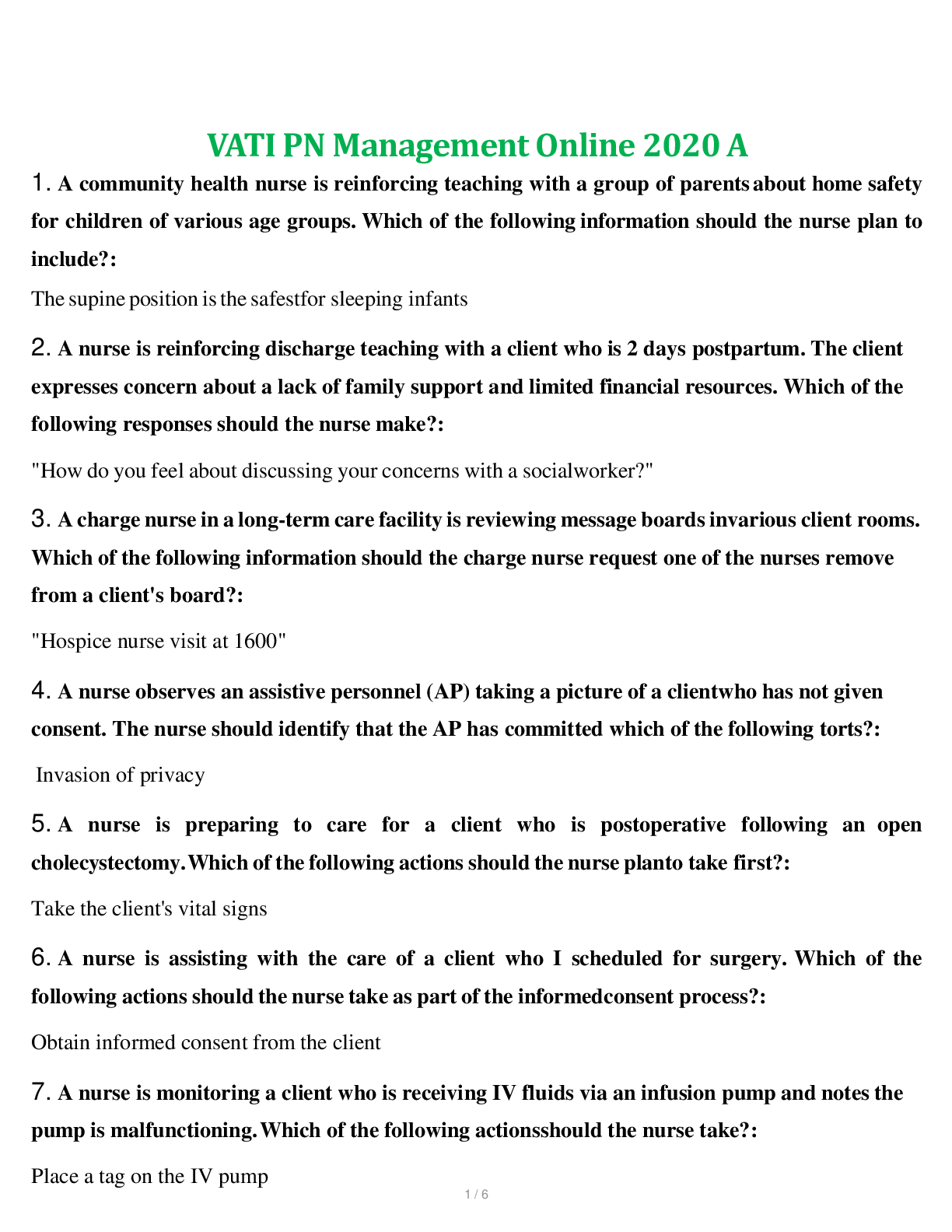


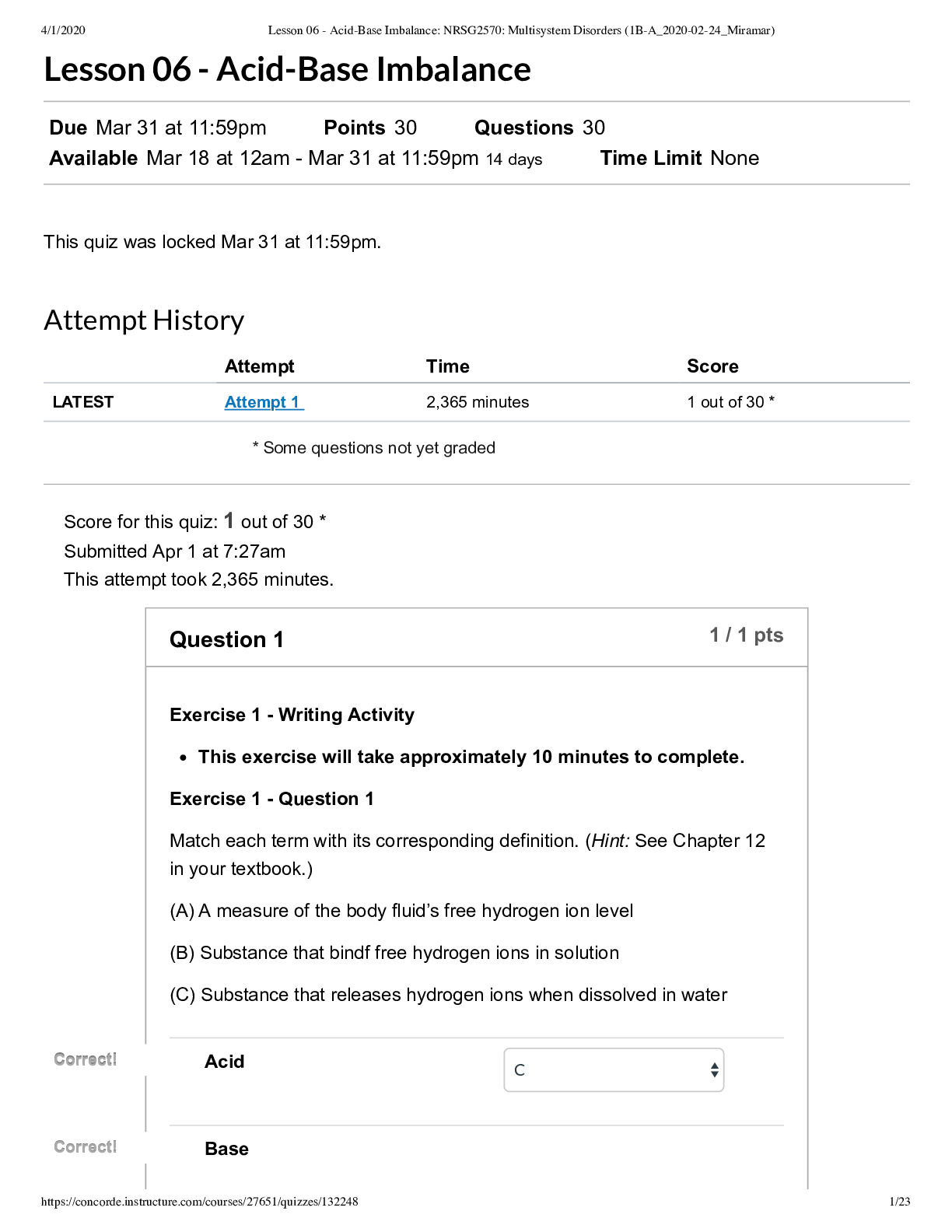


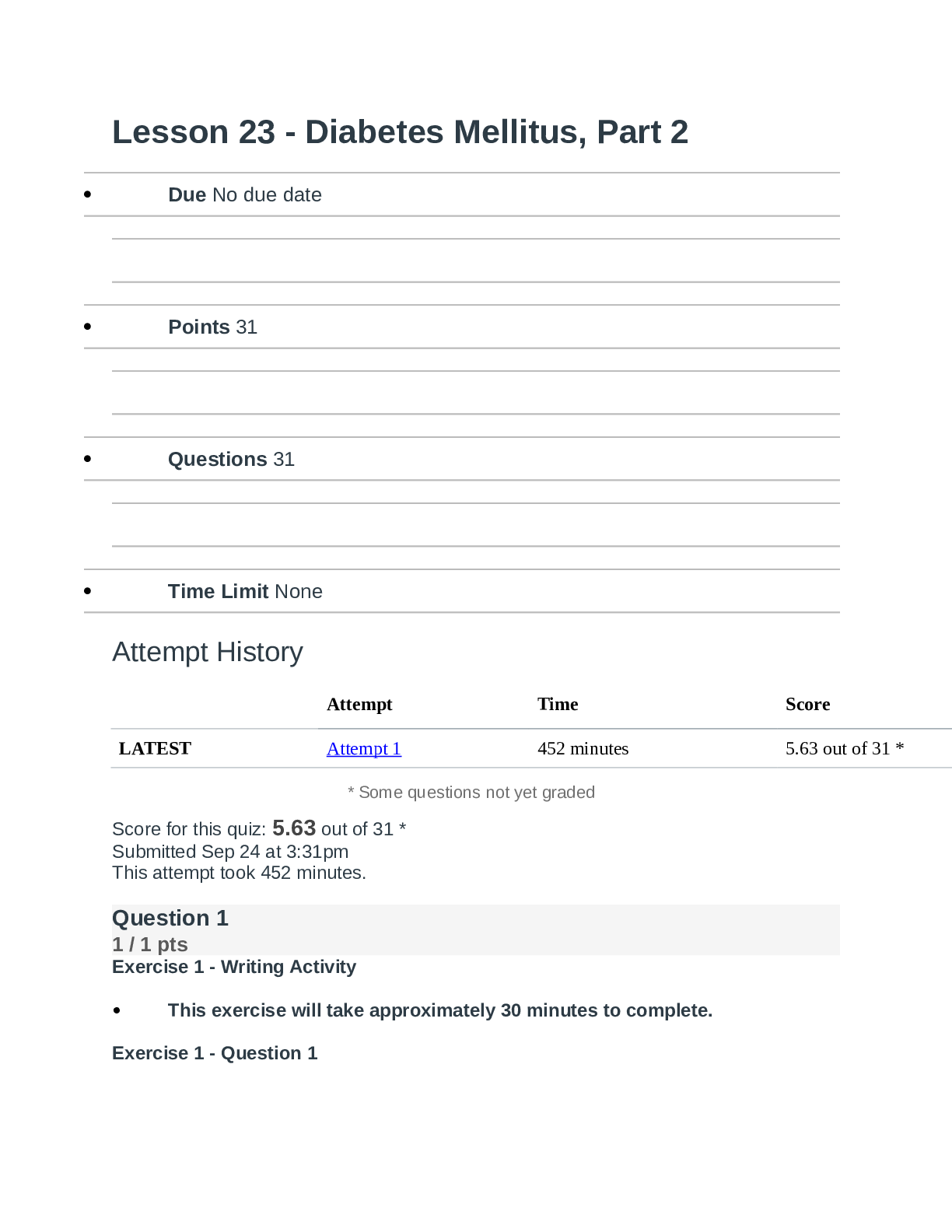

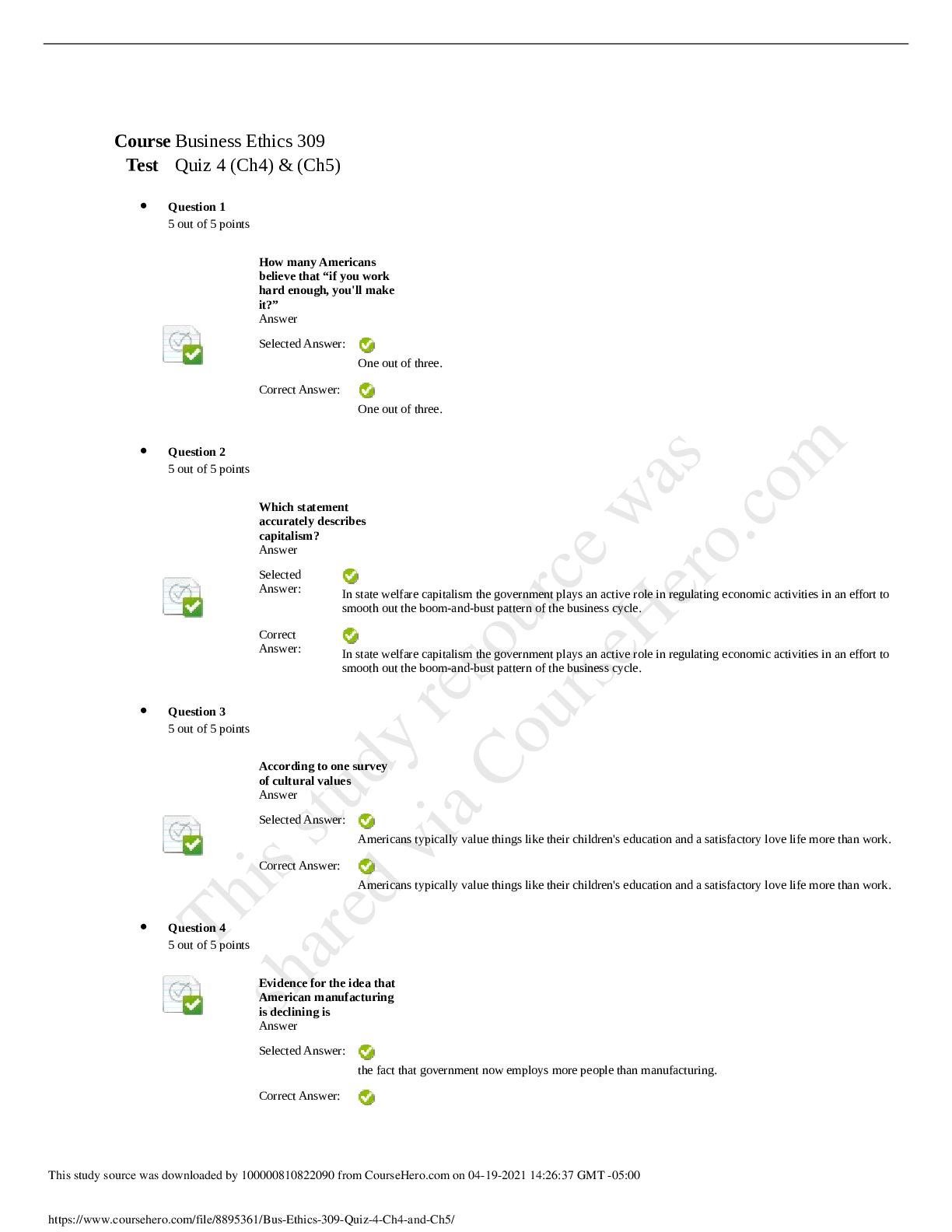






.png)
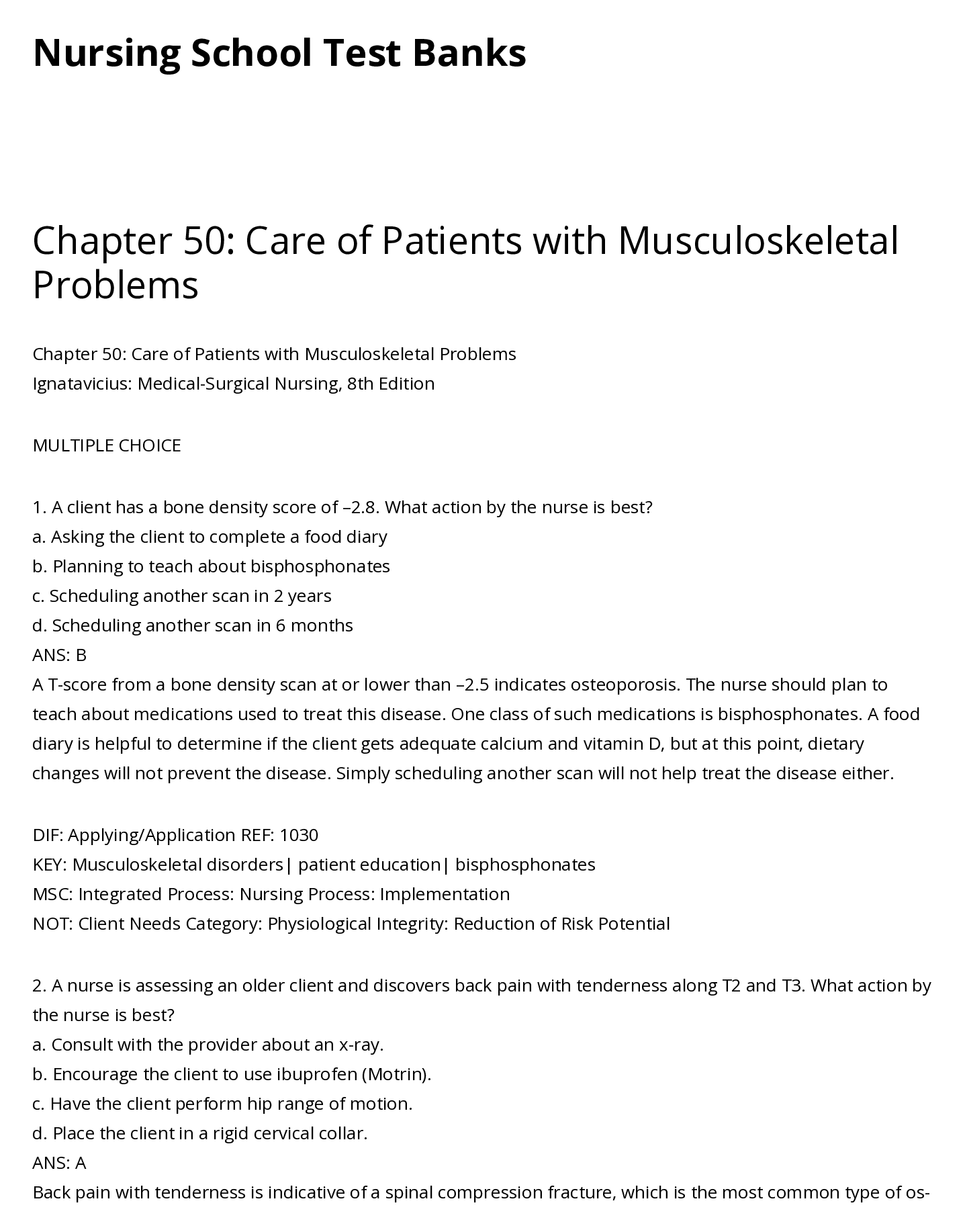
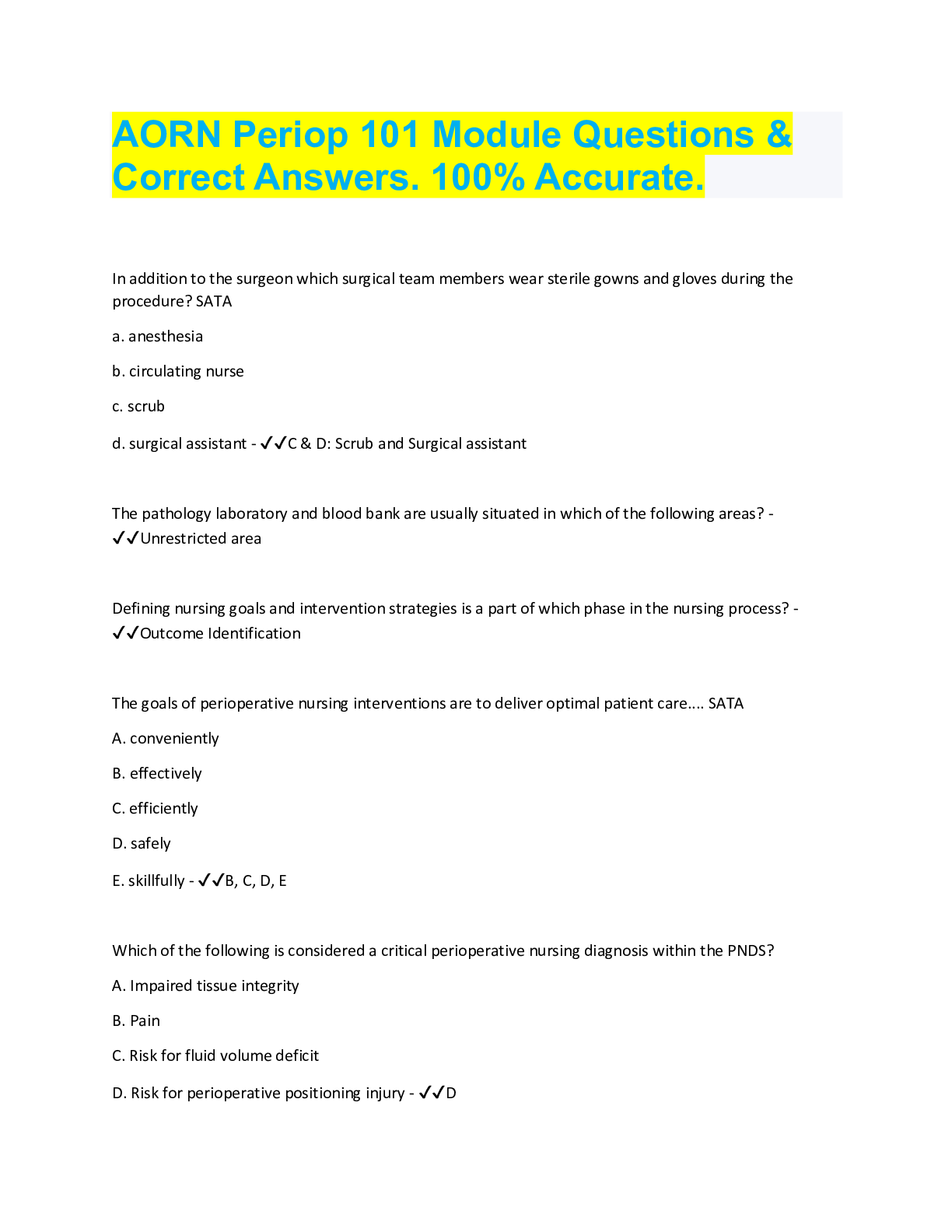






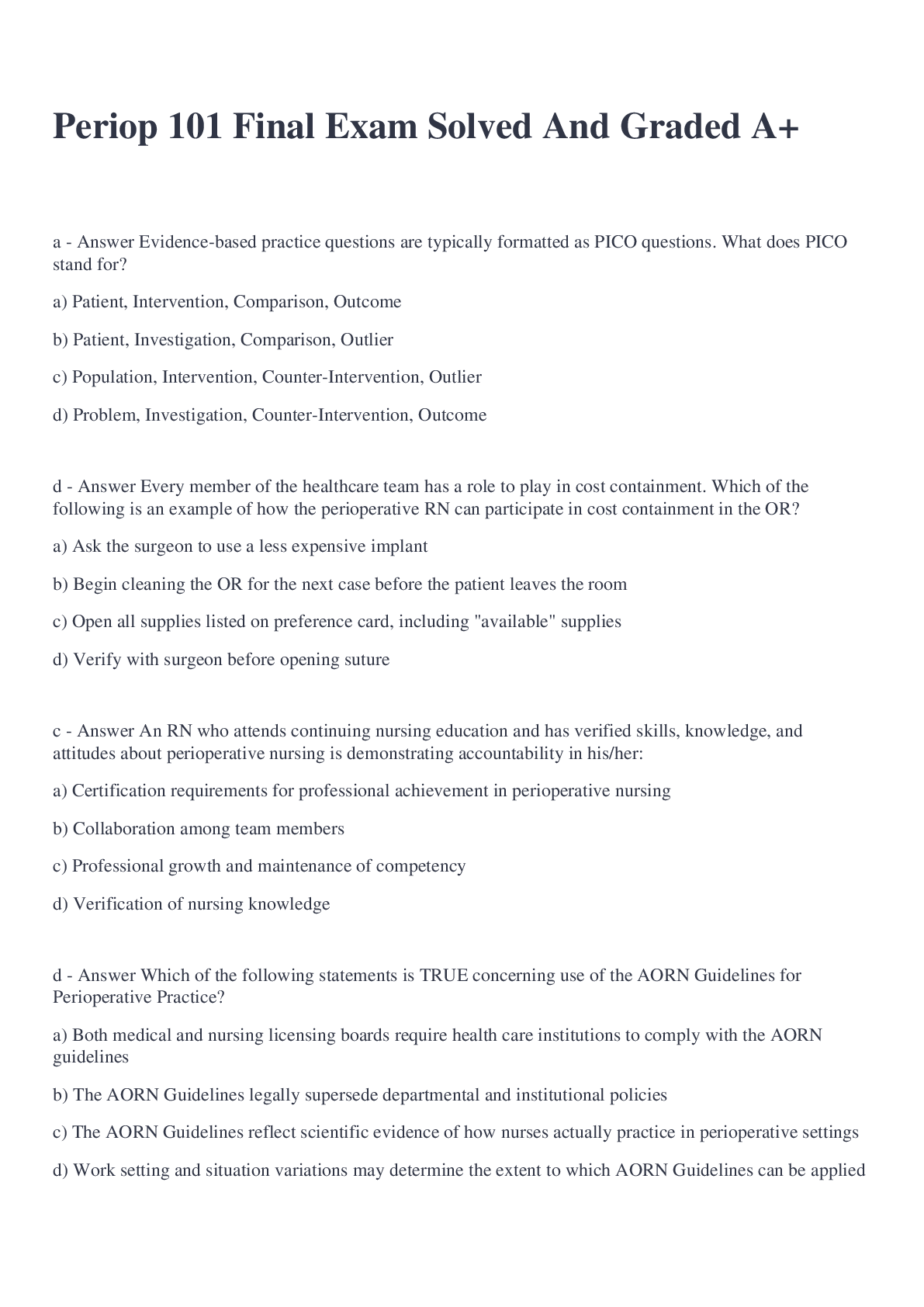


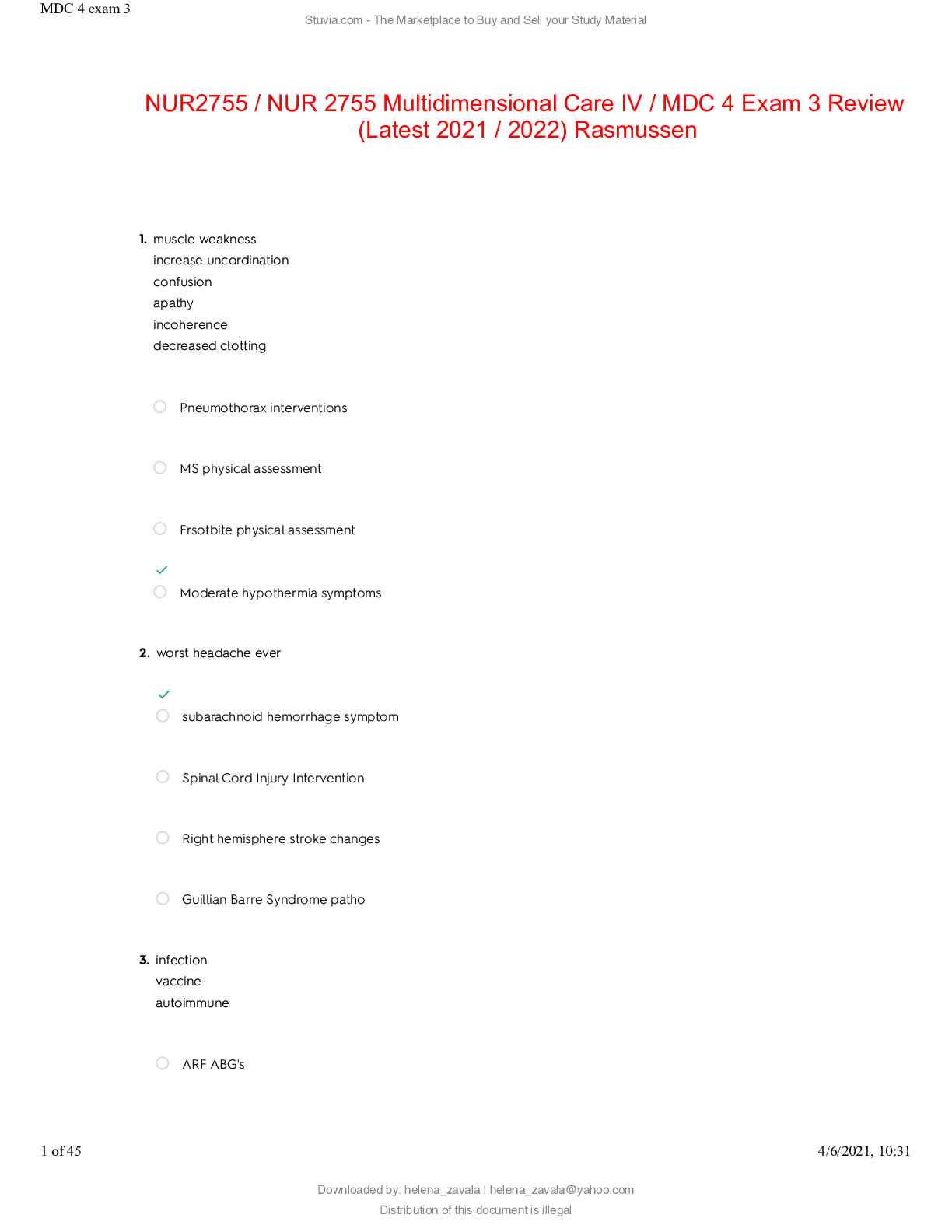


.png)

